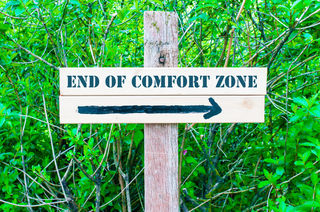OCD
The Best TED Talks for People With OCD: Part 5
Push out of your comfort zone and pursue the life you want to live.
Posted April 17, 2019
The last post in this series is about Dr. Tina Seelig’s talk “The little risks you can take to increase your luck.” I was drawn to this talk because it illustrates not only some of the problems with “all or nothing" thinking— something that plagues the majority of us with OCD—but steps you can take to address those issues.
Why we think in black or white
Why do people with OCD have a tendency to engage in the cognitive distortion of black and white thinking? Because we have a monster in our heads that divides the world into one of two categories: good or bad. See a bandaid on the floor at the supermarket? That’s BAD! Get too close to a coughing child in that same store who seems to be a walking germ factory? BAD! Find a sale on 100-count boxes of disposal rubber gloves to protect you from all the contaminants out there? Well, according to your OCD, that’s GOOD, of course!
One of the goals of exposure and response prevention therapy (ERP), the evidence-based treatment for OCD, is to help people with OCD move out of the black and white at the ends of the continuum and into the gray in the middle. Very few things in life are as black and white as OCD would have you believe (and we’ll discuss that more later in this post), and most of real life happens in the gray. Participating fully and happily in the gray uncertainty of life is what getting better is all about.
Think little
The first idea that Dr. Seelig shares that can help us happily live in the gray is when she talks about taking little risks. Many of us with OCD can be pretty risk-averse, and when presented with the opportunity to do something non-OCD related that pushes us out of our comfort zones, our minds will protest, “BUT WE CAN’T DO THAT!” Because of the vehemence of the all caps fit being thrown in our heads we back away, missing potential opportunities for growth, fun, and connection with others.

One of the reasons our minds can freak out when presented with unknown opportunities is that our OCD-influenced brains are really good at immediately distorting ideas, turning them into monumental tasks that have catastrophic endings. For instance, say you wanted to ask a girl out. Your mind might say, “But she’ll probably say no and everyone will hear us ask her and know she said no and then everyone will know that we’re losers and no one will want to hang out with us and we’ll end up not only with no date, but friendless and alone.” That scenario is enough to make anyone back away!
But what if, upon hearing your mind’s dire predictions, you recognized, “Oh, there’s that black and white thinking again, telling me I’m going to fail.” And then, what if you told yourself, “my goal here is to live in the gray” and then you found little ways to approach the task at hand, even though you’re feeling anxious? For instance, what about smiling at the girl you’d like to ask out when you pass her in the hall? What about complimenting her on the great presentation she gave? What about just engaging her in a quick conversation?
In other words, if your head is making ideas feel too big and scary, recognize that’s what your head does because you have OCD. Then find ways to live in the gray and take little risks that give you some feelings of success and help you get closer and closer to tackling the actual goal that you want to achieve.
Backing away from risks will never get us what we want. But breaking goals into little steps helps us push past all or nothing thinking and pursue opportunities that give life meaning.
Good and bad are not what they seem
The second idea Dr. Seelig proposes that is directly applicable to those of us with OCD is that the judgments of “good” and “bad” aren’t necessarily right. She talks about an entrepreneurship class she teaches where students rip up all the “good” business ideas and work instead with the “bad” ones. The seemingly bad idea of a restaurant in a garbage dump turns into a business that takes the leftovers from Michelin star restaurants and sells them the next day at a lower price, which sounds pretty good!
When you have OCD, you’re going to be predisposed to jump to conclusions, and most of those judgments will be negative, as OCD can find something wrong with almost everything! But what if you worked to stop your brain from jumping to judgments? What hidden opportunities that could change your life for the better might you find?

As I discuss in Is Fred in the Refrigerator?, not judging things as “good” or “bad” is one of my new rules for living life as free as possible from the influence of OCD. It’s so important to me that I had bracelets made that are engraved with this and other anti-OCD rules. I wear them to remind me to not only fight the tendency to think like my disorder but also to make sure I’m pushing myself out of my comfort zone and living my life happily in the gray.
I hope you’ve enjoyed this series about The Best TED Talks for People with OCD. Your OCD won’t want you to read the previous posts containing more ideas for empowering yourself and strengthening your recovery, but I hope you’ll defy its wishes and read them anyway!
3. How to change your attitude towards your anxiety to strip away OCD’s power
4. How to strengthen your recovery by loosening OCD’s grip of shame and embracing vulnerability.
For notifications of new blog posts as well as OCD-taming tips & resources, sign up for my Shoulders Back! newsletter.




